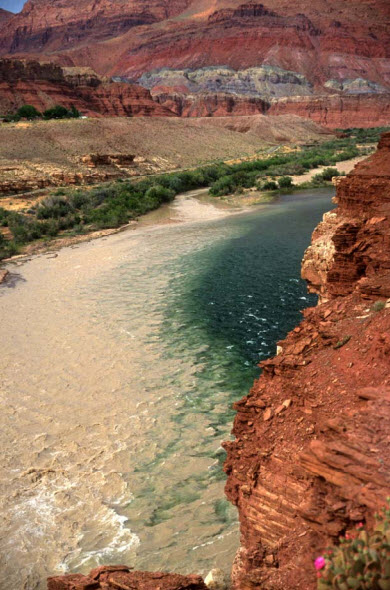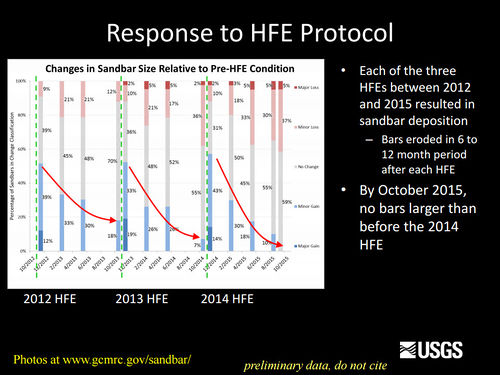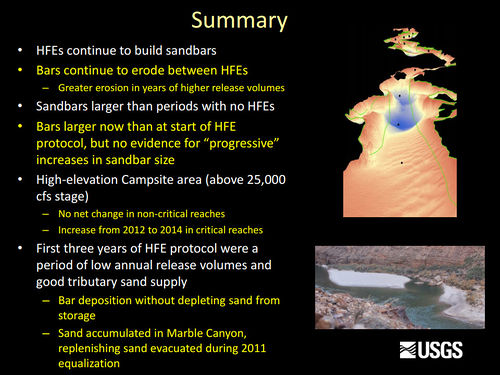Difference between revisions of "GCDAMP Sediment"
Cellsworth (Talk | contribs) |
Cellsworth (Talk | contribs) |
||
| Line 120: | Line 120: | ||
*[https://www.gcmrc.gov/discharge_qw_sediment/station/GCDAMP/GCMRC-GCLT1 Water Holes Canyon above the mouth] | *[https://www.gcmrc.gov/discharge_qw_sediment/station/GCDAMP/GCMRC-GCLT1 Water Holes Canyon above the mouth] | ||
| − | *[ | + | *[https://www.gcmrc.gov/discharge_qw_sediment/station/GCDAMP/09381800 Paria River near Kanab, UT] |
| + | *[https://www.gcmrc.gov/discharge_qw_sediment/station/GCDAMP/09382000 Paria River at Lees Ferry, AZ] | ||
*[http://www.gcmrc.gov/discharge_qw_sediment/station/GCDAMP/09380000 Colorado River at Lees Ferry] | *[http://www.gcmrc.gov/discharge_qw_sediment/station/GCDAMP/09380000 Colorado River at Lees Ferry] | ||
| − | *[http://www.gcmrc.gov/discharge_qw_sediment/station/GCDAMP/09383050 Colorado River | + | *[https://www.gcmrc.gov/discharge_qw_sediment/station/GCDAMP/GCMRC-MCLT1 Badger Creek below highway 89A near Vermillion Cliffs, AZ] |
| − | *[http://www.gcmrc.gov/discharge_qw_sediment/station/GCDAMP/09383100 Colorado River above | + | *[https://www.gcmrc.gov/discharge_qw_sediment/station/GCDAMP/GCMRC-MCLT2 Tanner Wash below highway 89A near Bitter Springs, AZ] |
| − | *[http://www.gcmrc.gov/discharge_qw_sediment/station/GCDAMP/09403000 Bright Angel Creek] | + | *[https://www.gcmrc.gov/discharge_qw_sediment/station/GCDAMP/GCMRC-MCLT3 House Rock Wash above Emmett Wash near Cliff Dwellers, AZ] |
| + | *[https://www.gcmrc.gov/discharge_qw_sediment/station/GCDAMP/GCMRC-MCLT5 North Canyon near Cliff Dwellers, AZ] | ||
| + | *[https://www.gcmrc.gov/discharge_qw_sediment/station/GCDAMP/GCMRC-MCLT6 Shinumo Wash in Twentynine Mile Canyon near Cedar Ridge, AZ] | ||
| + | *[http://www.gcmrc.gov/discharge_qw_sediment/station/GCDAMP/09383050 Colorado River near river mile 30] | ||
| + | *[http://www.gcmrc.gov/discharge_qw_sediment/station/GCDAMP/09383100 Colorado River above Little Colorado River near Desert View, AZ] | ||
| + | *[https://www.gcmrc.gov/discharge_qw_sediment/station/GCDAMP/09401500 Moenkopi Wash near Cameron, AZ] | ||
| + | *[https://www.gcmrc.gov/discharge_qw_sediment/station/GCDAMP/09401000 Little Colorado River at Grand Falls, AZ] | ||
| + | *[https://www.gcmrc.gov/discharge_qw_sediment/station/GCDAMP/09401200 Little Colorado River at Cameron, AZ] | ||
| + | *[https://www.gcmrc.gov/discharge_qw_sediment/station/GCDAMP/09402000 Little Colorado River near Cameron, AZ] | ||
| + | *[https://www.gcmrc.gov/discharge_qw_sediment/station/GCDAMP/09402300 Little Colorado River above the mouth near Desert View, AZ] | ||
| + | *[https://www.gcmrc.gov/discharge_qw_sediment/station/GCDAMP/09402500 Colorado River near Grand Canyon, AZ] | ||
| + | *[http://www.gcmrc.gov/discharge_qw_sediment/station/GCDAMP/09403000 Bright Angel Creek near Grand Canyon, AZ] | ||
*[http://www.gcmrc.gov/discharge_qw_sediment/station/GCDAMP/GCMRC-MCLT6 Shinumo Creek] | *[http://www.gcmrc.gov/discharge_qw_sediment/station/GCDAMP/GCMRC-MCLT6 Shinumo Creek] | ||
| − | + | *[http://www.gcmrc.gov/discharge_qw_sediment/station/GCDAMP/09403850 Kanab Creek above the mouth near Supai, AZ] | |
| − | + | *[http://www.gcmrc.gov/discharge_qw_sediment/station/GCDAMP/09404115 Havasu Creek above the mouth near Supai, AZ] | |
| − | *[http://www.gcmrc.gov/discharge_qw_sediment/station/GCDAMP/09403850 Kanab Creek] | + | *[http://www.gcmrc.gov/discharge_qw_sediment/station/GCDAMP/09404120 Colorado River above National Canyon near Supai, AZ] |
| − | *[http://www.gcmrc.gov/discharge_qw_sediment/station/GCDAMP/09404115 Havasu Creek] | + | *[http://www.gcmrc.gov/discharge_qw_sediment/station/GCDAMP/09404200 Colorado River above Diamond Creek near Peach Springs, AZ] |
| − | *[http://www.gcmrc.gov/discharge_qw_sediment/station/GCDAMP/09404120 Colorado River | + | |
| − | *[http://www.gcmrc.gov/discharge_qw_sediment/station/GCDAMP/09404200 Colorado River | + | |
| − | + | ||
|- | |- | ||
Revision as of 17:54, 21 February 2020
|
|
Sediment and GeomorphologyErosion of sandbars (beaches) along the Colorado River in Grand Canyon was first reported in the early 1970s, approximately 10 years after completion of Glen Canyon Dam. Since then, scientific studies have been conducted to monitor changes in sandbars and changes in the amount of sand stored on the bed of the river. One of the outcomes of these studies has been the implementation of flow experiments intended to rebuild eroded sandbars, especially by the release of controlled floods, also called High Flow Experiments, or HFEs, from Glen Canyon Dam. The sediment and geomorphology projects at Grand Canyon Monitoring and Research Center include the collection and processing of data to provide information needed to conduct controlled floods and to evaluate the outcome of each controlled flood and the long-term effects of controlled floods and normal dam operations on sediment-related resources. [1] Beginning in 1998, recreational campsite area has also been measured on a subset of the sandbar monitoring sites. Campsite areas are defined as areas that are flat (less than 8 degree slope), smooth (not rocky), and clear of dense vegetation. Monitoring data show that vegetation expansion and sandbar erosion/deposition contribute to reductions in campsite area. LTEMP Resource Goal for SedimentIncrease and retain fine sediment volume, area, and distribution in the Glen, Marble, and Grand Canyon reaches above the elevation of the average base flow for ecological, cultural, and recreational purposes. Desired Future Condition for Sediment-Related ResourcesHigh elevation open riparian sediment deposits along the Colorado River in sufficient volume, area, and distribution so as to provide habitat to sustain native biota and desired ecosystem processes |
| --- |
--- |
--- |
|---|



